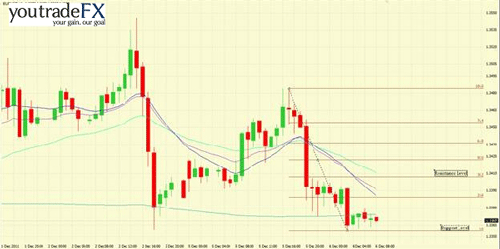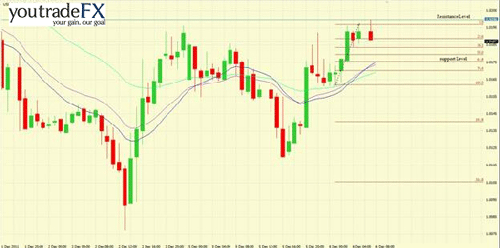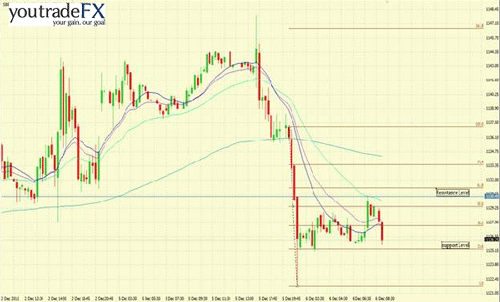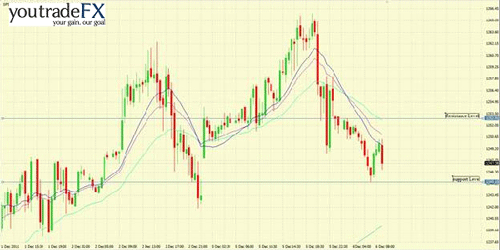U.S service Sector fell by more than expected to 52.0 in November from 52.9 in October, according to a report released by the Institute for Supply Management on Monday and the U.S. Factory Orders dipped by slightly more than expected to $450 billion for the month according to figures released Monday by the Commerce Department. The Federal Reserve Bank of New York announced that they will enter into paired contracts to buy and sell mortgage securities and this move may reduce funding costs.
The Reserve Bank of Australia (RBA) decreased its benchmark interest rate by 0.25 basis points to 4.25 percent as expected for a second straight month. The Reserve Bank Governor Glenn Stevens said in a statement that financing conditions have become much more difficult, especially in Europe. The Europe’s fiscal crisis threatens to slow the nation’s commodity exports, sending the nation’s currency lower.
Germany’s leader Chancellor Angela Merkel and France leader President Nicolas Sarkozy pushed for a rewrite of the European Union’s governing treaties to tighten economic cooperation as a first step to ending the debt crisis. Both leaders agreed that automatic sanctions should be applied to those countries, which fail to respect the 3% GDP deficit. Eurostat released positive data on Monday that showed Eurozone retail sales rose more than expected in October, the volume of retail trade increased by 0.4 percent month-on-month, compared to a 0.6 percent drop in September. Britain's dominant services sector picked up slightly last month, defying forecasts it would stagnate. The latest news from Europe is that Standard and Poor’s put Germany, France and 13 other euro-area nations on review for a downgrade yesterday, saying that the continuing disagreements among European policy makers on how to tackle the region’s debt crisis risk damaging their financial stability.
EUR/USD
Euro against USD started today’s session on negative note and decreased by nearly 40pips early in the morning. The Euro is under pressure after the S&P put 15 nations in the Euro Zone including Germany and France on guard for a downgrade, yesterday. This downgrade news has eclipsed Angela Merkel and Nicolas Sarkozy efforts to tackle the debt crisis (See paragraph above). The pair is currently trading in the narrow range of 1.3379-1.3360. The pair current support levels are at 1.3360-1.3355 and the resistance level is at today’s high 1.3379. The market sentiment remains weak and it seems the pair will fall further when the European market will be in action.

USD/CAD
The pair kept its bullish trend this morning and peaked at a session high of 1.0200. The Bank of Canada is to release its interest rate decision later today and according to Bloomberg, the Interest rate will probably be unchanged today and say that economic growth and price stability are still being threatened by Europe’s debt crisis. Investors should be cautious on the pair and should most probably wait for the news to be published. The strong support level is at 1.0175 (61.8% Fibonnaci level) and the resistance is at 1.0200 (session high).

EUR/AUD:
The Australian dollar decreased to fresh session lows against the Euro after the RBA announced on Tuesday it would cut the cash rate by another 25 basis points to 4.25 percent. EUR/AUD broke through resistance in the 1.3075 area following the announcement early this morning. The pair peaked at 1.3143 intra trade and is now trading in the region of 1.3143 and 1.3125. The Euro may suffer a correction later when the European session will open following the downgrading of 15 European nations. The resistance level is at 1.3143 and the support levels are at 1.3106 and 1.3093.
Soybean futures rose intra trade Monday, trading close to a seven-day high as adverse weather forecasts fuelled concerns over crop conditions in Brazil and hopes that European leaders will boost efforts to tackle the region's debt crisis gave further support to the commodity. However, the Latter suffered a massive set back late in the afternoon and gave up more than $26 a bushel. Today Soybean Futures are trading at 1126.38 below the 38.2% Fibonacci retracement level. Investors can enter the market at support level 1121.85 with a take profit target of the range 1126.05-1129.25 a bushel.

SP&500:
U.S. stocks rose to a high of 1265.92 points yesterday as optimism that Europe will reduce its debt crisis helped the market to make the best weekly rally since 2009 but following the news that S&P will downgrade 15 European countries spoiled the positive mood on the market and the index decreased significantly to trade at a low of 1247.88 points. Today, the index is trading further down at 1245.10 points. Market sentiments remain very low and investors should be cautious on the index.

The Reserve Bank of Australia (RBA) decreased its benchmark interest rate by 0.25 basis points to 4.25 percent as expected for a second straight month. The Reserve Bank Governor Glenn Stevens said in a statement that financing conditions have become much more difficult, especially in Europe. The Europe’s fiscal crisis threatens to slow the nation’s commodity exports, sending the nation’s currency lower.
Germany’s leader Chancellor Angela Merkel and France leader President Nicolas Sarkozy pushed for a rewrite of the European Union’s governing treaties to tighten economic cooperation as a first step to ending the debt crisis. Both leaders agreed that automatic sanctions should be applied to those countries, which fail to respect the 3% GDP deficit. Eurostat released positive data on Monday that showed Eurozone retail sales rose more than expected in October, the volume of retail trade increased by 0.4 percent month-on-month, compared to a 0.6 percent drop in September. Britain's dominant services sector picked up slightly last month, defying forecasts it would stagnate. The latest news from Europe is that Standard and Poor’s put Germany, France and 13 other euro-area nations on review for a downgrade yesterday, saying that the continuing disagreements among European policy makers on how to tackle the region’s debt crisis risk damaging their financial stability.
EUR/USD
Euro against USD started today’s session on negative note and decreased by nearly 40pips early in the morning. The Euro is under pressure after the S&P put 15 nations in the Euro Zone including Germany and France on guard for a downgrade, yesterday. This downgrade news has eclipsed Angela Merkel and Nicolas Sarkozy efforts to tackle the debt crisis (See paragraph above). The pair is currently trading in the narrow range of 1.3379-1.3360. The pair current support levels are at 1.3360-1.3355 and the resistance level is at today’s high 1.3379. The market sentiment remains weak and it seems the pair will fall further when the European market will be in action.

USD/CAD
The pair kept its bullish trend this morning and peaked at a session high of 1.0200. The Bank of Canada is to release its interest rate decision later today and according to Bloomberg, the Interest rate will probably be unchanged today and say that economic growth and price stability are still being threatened by Europe’s debt crisis. Investors should be cautious on the pair and should most probably wait for the news to be published. The strong support level is at 1.0175 (61.8% Fibonnaci level) and the resistance is at 1.0200 (session high).

EUR/AUD:
The Australian dollar decreased to fresh session lows against the Euro after the RBA announced on Tuesday it would cut the cash rate by another 25 basis points to 4.25 percent. EUR/AUD broke through resistance in the 1.3075 area following the announcement early this morning. The pair peaked at 1.3143 intra trade and is now trading in the region of 1.3143 and 1.3125. The Euro may suffer a correction later when the European session will open following the downgrading of 15 European nations. The resistance level is at 1.3143 and the support levels are at 1.3106 and 1.3093.
Soybean futures rose intra trade Monday, trading close to a seven-day high as adverse weather forecasts fuelled concerns over crop conditions in Brazil and hopes that European leaders will boost efforts to tackle the region's debt crisis gave further support to the commodity. However, the Latter suffered a massive set back late in the afternoon and gave up more than $26 a bushel. Today Soybean Futures are trading at 1126.38 below the 38.2% Fibonacci retracement level. Investors can enter the market at support level 1121.85 with a take profit target of the range 1126.05-1129.25 a bushel.

SP&500:
U.S. stocks rose to a high of 1265.92 points yesterday as optimism that Europe will reduce its debt crisis helped the market to make the best weekly rally since 2009 but following the news that S&P will downgrade 15 European countries spoiled the positive mood on the market and the index decreased significantly to trade at a low of 1247.88 points. Today, the index is trading further down at 1245.10 points. Market sentiments remain very low and investors should be cautious on the index.

